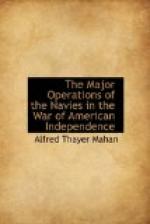Cornwallis, not content with his late success, decided to push on into North Carolina. Thus doing, he separated himself from his naval base in Charleston, communication with which by land he had not force to maintain, and could recover effective touch with the sea only in Chesapeake Bay. This conclusion was not apparent from the first. In North Carolina, the British general did not receive from the inhabitants the substantial support which he had expected, and found himself instead in a very difficult and wild country, confronted by General Greene, the second in ability of all the American leaders. Harassed and baffled, he was compelled to order supplies to be sent by sea to Wilmington, North Carolina, an out-of-the-way and inferior port, to which he turned aside, arriving exhausted on the 7th of April, 1781. The question as to his future course remained to be settled. To return to Charleston by sea was in his power, but to do so would be an open confession of failure,—that he could not return by land, through the country by which he had come—much the same dilemma as that of Howe and Clinton in Philadelphia. To support him in his distress by a diversion, Sir Henry Clinton had sent two successive detachments to ravage the valley of the James River in Virginia. These were still there, under the command of General Phillips; and Cornwallis, in the circumstances, could see many reasons that thither was the very scene to carry the British operations. On the 25th of April, 1781, he left Wilmington, and a month later joined the division at Petersburg, Virginia, then commanded by Benedict Arnold; Phillips having died. There, in touch now with his fate, we must leave him for the moment.
To complete the naval transactions of 1780, it is necessary to mention briefly two incidents, trivial in themselves, but significant, not only as associated with the greater movements of the campaign, but as indicative of the naval policy of the States which were at war. The two, though not otherwise connected, have a certain unity of interest, in that the same British officer commanded on both occasions.
It will be remembered that in Byron’s action off Grenada, in July, 1779, the 64-gun ship Lion received such injuries that her commander, Captain Cornwallis, had been compelled to run down before the trade-winds to Jamaica, in order to save her from capture. Since that time she had remained there, as one of the squadron of Vice-Admiral Sir Peter Parker. In March, 1780, still commanded by Cornwallis, she was making an ordinary service cruise off the north side of Haiti, having in company the Bristol, 50, and the Janus, 44. On the 20th of March, off Monte Christi, a number of sail were sighted to the eastward, which proved to be a French convoy, on its way from Martinique to Cap Francois, protected by La Motte-Picquet’s squadron of two 74’s, one 64, one 50, and a frigate. The French merchant ships were ordered to crowd sail for their port, while




